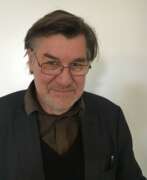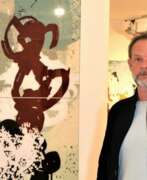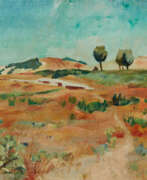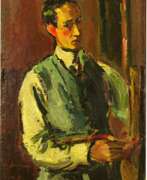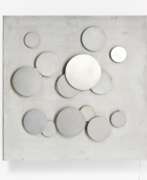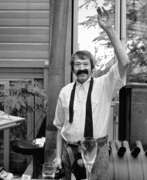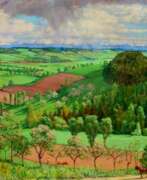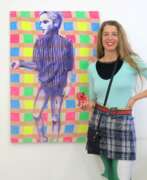Austria Contemporary art


Marc Adrian is an Austrian conceptual artist and filmmaker.
Adrian studied sculpture at the Vienna Academy of Fine Arts, from 1953 he became interested in cinema, kinetics, rhythmic interference, problems of optical structures, etc. Adrian is considered one of the pioneers of film-oriented media art. He specialized in kinetic objects, anti-cinema and computer art.
Marc Adrian has taught at various universities in Europe and lectured to American students.


Christian Ludwig Attersee, born Christian Ludwig, is an Austrian media artist living in Vienna and Semmering in Lower Austria.
The artist took his middle name, Attersee, from the area where he spent his youth. He studied at the Vienna Academy of Applied Arts and his work was characterized early on by flamboyant sexualization. He is known not only as a visual artist, but also as a musician, writer, object artist, designer, stage designer and film director. In the 1960s and 1970s he also created series on themes of food, everyday objects, beauty and cosmetics.
Attersee is known above all as one of the leading representatives of objective painting in Europe in the last 50 years. In the second half of the seventies he became the founder of the "New Austrian Painting". From 1990 to 2009, Atterse held a chair at the Vienna University of Applied Arts.


Thomas Baumann is an Austrian artist and filmmaker living and working in Vienna.
Baumann studied at the Academy of Fine Arts in Vienna, but is engaged in a wide range of creative endeavors. He mixes categories of art and challenges values and forms. Through his electronic sculptures, machine paintings, films and installations that give visitors their own freedom of action, Baumann searches for structural connections between material and mental spaces.
For example, one of his spatial sculptures with a pre-programmed score: silver foil moves in a certain rhythm, it straightens, contracts or expands. The sculpture is constantly changing its form - it destroys the shape it has just taken to create a new one. Baumann also constructs artworks from floor ropes, swings, doors, organ pipes and other objects. Many of his works contain acoustic elements. Since 1990, Bauman has also made films and videos.


Alexandra Baumgartner is a German artist working in various fields of art: collage, installation, painting and object art. Her work is most often based on found photographs, as well as on furniture and everyday objects. Historical portraits and images are cut out, partially painted over and combined, putting mostly anonymous source material into new contexts.


Albert Birkle was a German and Austrian painter, decorator, muralist and glass painter.
Albert's father was the artist Karl Birkle, from whom he received his initial training as a decorative painter, then studied at the Hochschule für die bildenden Künste (now the Berlin University of the Arts). Birkle developed a unique style based on Expressionism and the New Objectivity/Neue Sachlichkeit style. His subjects were lonely, mystical landscapes, typical scenes of Berlin in the 20s and 30s, portraits and religious scenes.
In 1932, fleeing the National Socialists, Albert Birkle moved to Salzburg, Austria, but nevertheless represented Germany at the Venice Biennale as early as 1936. In 1937, his work was declared "degenerate" in Germany and withdrawn from state collections. In 1946, Birkle was granted Austrian citizenship and began working on religious frescoes and decorative windows for various churches and oil paintings. The 1950s and 60s were filled with intense creativity in glass painting.


Herbert Brandl is one of the most famous Austrian expressionist artists. He achieved success through his large-format works.
Landscape as a theme was always dominant in his work, where pictorial abstraction and subjectivity alternate. Since the beginning of the new millennium, Brandl's passion for the monumentality of mountain landscapes has become increasingly evident. Using various formats and techniques, the artist has reinterpreted the theme of mountains, playing with expressive gestures, abstract colour spaces and massive forms.


Ernst Caramelle is an Austrian artist. He is known for his conceptual art, which often involves the use of painting and drawing as a means of exploring the relationship between perception and representation.
Caramelle studied at the University of Applied Arts in Vienna and later taught at the Academy of Fine Arts Vienna. His work is characterized by a playful approach to art-making, often blurring the boundaries between painting, drawing, and installation.
Caramelle's work often involves the use of trompe-l'oeil techniques and other visual illusions, inviting viewers to question their perception of the art object and the space in which it is displayed. He frequently incorporates architectural elements into his work, creating site-specific installations that engage with the surrounding environment.
Caramelle has exhibited his work internationally, including at the Venice Biennale, the Documenta in Kassel, and the Museum of Modern Art in New York. He has also been awarded numerous awards and honors, including the Grand Austrian State Prize for Visual Arts in 2013.


Georg Dinz is a contemporary Austrian artist. After studying at the Vienna University of Applied Arts, Dienz lives and works as a room and stage designer in the Viennese punk scene. Shortly after the fall of the Wall, Dienz moves to Berlin, where he takes part in various art projects in the wild post-reunification period. Today he concentrates on free painting in his studio in the former Berlin artist district of Prenzlauer Berg. Georg Dienz's works are stylistically characterized by a flat and clear application of paint and can be described as "reduced realism".


Josef Dobrowsky was an Austrian painter and member of the Zinkerbacher Artist Colony that lived and worked together at Lake Wolfgang until its dissolution after Austria was annexed by Germany, known as the Anschluss, in 1938.


Albert Ennemoser is a contemporary Austrian artist. Traveled extensively throughout Europe, USA, Africa and Asia. In 1972 he immigrated to Ireland, then moved to Scotland. He studied painting at the Glasgow School of Art and Jordanhill College of Education. Worked as an illustrator for BBC-TV-Scotland and as a designer for NAEF in Switzerland. He received several awards and was artistic director of the Tiroler Literaturwettbewerb für Jugendliche. His work has been exhibited both nationally and internationally.


Knopp Ferro (born Walter Hinterker in Bensberg) is an Austrian sculptor, painter and performance artist. He lives and works in Munich and in Inning am Ammersee.
His best-known works — both as an individual artist and as part of the artist group Jet Ferro — are now in international galleries and exhibition houses and have already been shown by invitation in the outdoor area of the documenta in Kassel.


Wolfgang Flatz is a contemporary Austrian artist, stage designer, musician and composer. Currently lives and works in Munich, Germany.
After engaging with contemporary art movements such as Heppening and Viennese Actionism, Flatz creates works using a variety of media - painting, sculpture, performance, video, computer, film, photography, theatre, music, design and architecture. Subjects include voyeurism, the body, violence, aggression, pain, love, politics and audience interaction.
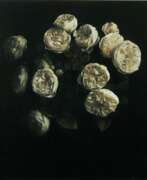

Norbert Fleischmann is an Austrian artist whose passion for painting can be called encyclopedic, because it encompasses a variety of styles and genres, motifs, painting styles and media influences, even forms of presentation and representation.


Hans Fronius was an Austrian painter and illustrator. His work is considered an example of "expressive realism," and he painted portraits, street scenes, and literary interpretations. Fronius was one of the first to illustrate stories by Franz Kafka, as well as works by Edgar Allan Poe and Robert Louis Stevenson.


Ernst Fuchs was an Austrian painter, draftsman, printmaker, sculptor, architect, stage designer, composer, poet, and one of the founders of the Vienna School of Fantastic Realism. In 1972, he acquired the derelict Otto Wagner Villa in Hütteldorf, which he restored and transformed. The villa was inaugurated as the Ernst Fuchs Museum in 1988.


Jakob Gasteiger is an Austrian artist, representative of analytical painting, living and working in Vienna and in Weinviertel.
Gasteiger studied stage design at the University of Music and Performing Arts in Salzburg and attended the Institute for Teaching and Research in Graphic Arts. Since 2013, he has been working in the studio at Weinviertel. Jakob Gasteiger is considered a representative of analytical painting.
In his works he questions the parameters of painting, expanding and breaking the boundaries of graphics, painting and sculpture. The artist's most extensive group of works are predominantly monochrome paintings with relief structures, which are formed with the help of a comb spatula when applying paint to the background of the painting. As of late 2018, Gasteiger has expanded this group of works through the use of neon colors. He also creates aluminum sculptures and installations.


Roger Gressl is a contemporary Austrian painter. His overpaintings are well known. Gressl has been working as a freelance painter and graphic artist since 1987. His works have been shown in numerous solo exhibitions in Berlin, Krems, St. Pölten, Innsbruck, Vienna, Frankfurt, Heidelberg, Mannheim, Feldkirch, Bergamo, Wels and London. Since 1988 he has been regularly represented at international art fairs in Basel, Barcelona, Frankfurt, Florence, Ghent, Los Angeles and Nuremberg. Gressl's recognizability lies in the consistent use and treatment of his color combinations and the acrylic mixing technique used. The artist tries to achieve an effect through complementary colours, to form axes and knows how to create a closed, harmonious color composition based on aggressive colors using shades of gray and white.


Robert Hammerstiel, an Austrian painter and engraver born on 18 February 1933 in Vršac, Yugoslavia, was renowned for his profound and impactful art. His works, deeply influenced by his experiences, were widely exhibited in prominent cities like New York, Vienna, Cairo, and Brussels.
Hammerstiel's journey in the art world was notable for its depth and variety. In 1988, he transitioned to a full-time artistic career, leaving behind his work in the steel industry. This shift marked a new phase in his life, allowing him to fully dedicate himself to his art. One of his significant works includes "Von Ikonen und Ratten: Eine Banater Kindheit 1939 – 1949," which comprises 32 woodcuts, highlighting his skill in both writing and visual arts. His talent was recognized with several prestigious honors, including the Austrian Decoration for Science and Art in 1998 and the Austrian State Prize for Graphics in 1973.
Hammerstiel's art was not just limited to traditional formats; in 2007, he impressively wrapped the Ringturm in Vienna with a 4,000 square meter painting. His works are a part of various collections and have been displayed in significant exhibitions. Notably, the Leopold Museum in Vienna featured his graphic work in an exhibition titled "Winterreise", inspired by Schubert's song cycle, showcasing a series of drawings and woodcuts.
Robert Hammerstiel's influence in the art world extended beyond his lifetime, culminating in his birth town dedicating a museum to his works in 2010. His passing on 23 November 2020 marked the end of an era but left behind a rich legacy that continues to inspire artists and art lovers globally. His work is a testament to the power of art in expressing the complexities of human experiences and emotions.
For collectors, auctioneers, and experts in art and antiques, the works of Robert Hammerstiel offer a unique blend of cultural richness and profound artistic expression. His art, characterized by its emotional depth and technical skill, continues to hold a special place in the world of fine arts.
To stay informed about exhibitions, sales, and auction events related to Robert Hammerstiel's art, sign up for updates. This subscription will keep you updated on new opportunities to engage with the work of this influential Austrian artist.


Tom Hartwig is an Austrian artist and restorer.
He trained as an art restorer in Salzburg, where he also met famous artists. Since 1974 he has worked in Germany, including as an art restorer, but he has become increasingly fascinated by painting.
Tom Hartwig's world is colorful and strange; he creates powerful, large-format works, which he often frames as diptychs or triptychs. He is fascinated by the processes of nature and its power, especially "creative destruction. A volcanic eruption preparing the earth for a new life, a planetary explosion resulting in the formation of thousands of stars are the main subjects of the artist.


Gottfried Helnwein is an Austrian-Irish visual artist. He has worked as a painter, draftsman, photographer, muralist, sculptor, installation and performance artist, using a wide variety of techniques and media.
His work is concerned primarily with psychological and sociological anxiety, historical issues and political topics. His subject matter is the human condition. The metaphor for his art is dominated by the image of the child, particularly the wounded child, scarred physically and emotionally from within. His works often reference taboo and controversial issues from recent history, especially the Nazi rule and the horror of the Holocaust. As a result, his work is often considered provocative and controversial.


Wolfgang Herzig was an Austrian painter and sculptor known for his critical portrayal of social realities. In his figurative paintings he draws attention to human weaknesses in everyday life.
There is a sense of social criticism in Herzig's work, but he never turns his characters into caricatures. Over time, the artist came to a peculiar two-dimensional form of plastics.


Adi Holzer is an Austrian visual artist, illustrator, draughtsman, painter, graphic artist, glass painter and sculptor of bronze sculptures and glass sculptures. He works alternately in his studios in Værløse in Denmark and Winklern in Austria. In Austria he is a member of the Carinthian Art Association.


Friedensreich Regentag Dunkelbunt Hundertwasser was an Austrian visual artist and architect who also worked in the field of environmental protection.
Hundertwasser stood out as an opponent of "a straight line" and any standardization, expressing this concept in the field of building design. His best known work is the Hundertwasserhaus in Vienna, which has become a notable place of interest in the Austrian capital, characterised by imaginative vitality and uniqueness.


Wilhelm Kaufmann is an Austrian artist who has been called the master of the moment.
He studied at the Imperial Royal Academy of Fine Arts, then worked as a painter and track and field athlete at the same time. Kaufmann used color dynamics to masterfully depict momentary scenes of athletes' movements during competitions. He also painted colorful still lifes, landscapes and portraits.
Wilhelm Kaufmann was a member of the Professional Association of Austrian Visual Artists, the Sonderbund of Austrian Artists, the Vienna Art Association and the Vienna Hagenbund, the Vienna Secession and the Vienna Society of Artists, Künstlerhaus.
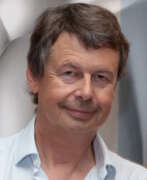

Peter Kogler is an Austrian artist who creates illusionary spaces.
He studied at the Academy of Fine Arts in Vienna and teaches at the Academy of Fine Arts in Munich.
Peter Kogler is a pioneering artist in the field of computer art. Using cutting-edge technology, the artist uses a series of repeating motifs materialized in various forms: two- and three-dimensional prints, sculptures, furniture, wallpaper, lighting fixtures, collages and other installations.


Elmar Kopp is an Austrian painter and sculptor, received artistic training from Toni Kirchmayr in Innsbruck. Despite losing his right hand in a work accident in 1949, he studied painting under Josef Dobrowsky and Herbert Boeckl, and sculpture under Fritz Wotruba at the Academy of Fine Arts in Vienna from 1951. Kopp completed his studies in 1954 and became a freelance artist in Imst. He created landscape, floral, and figurative paintings, as well as numerous public artworks such as sculptures, frescoes, sgraffiti, and mosaics. Kopp also provided designs for stained glass windows and tapestries woven by his wife, Midi. He traveled extensively throughout Europe, Africa, and Asia. In 1982, he was awarded the title of Professor by President Rudolf Kirchschläger.


Alfred Kornberger was an Austrian painter and graphic artist. He studied painting with Professor Robin Christian Andersen at the Academy of Fine Arts in Vienna.
Stylistically, he dealt with the different facets of classical modernism and was inspired by Pablo Picasso's late work as well as by the depictions of surrealist artists. In his early years he devoted himself to various themes from the world of industry as well as topographical depictions. Later he turned almost exclusively to the depiction of the female nude.
Alfred Kornberger's work is part of the great Austrian tradition of body-oriented art, which ranges from Egon Schiele to Alfred Hrdlicka. His central theme, the female nude, is not only a projection of sensual desire but also an expression of psychological states.


Suse Krawagna is an Austrian artist and graphic artist.
Suse Krawagna studied at the Academy of Fine Arts in Vienna and at the Royal College of Art in London. Her work is based on the observation of architectural details, her attention is drawn to shapes, clusters of forms and details of objects. Suze creates her paintings in series, demonstrating their dramatic variation through slight variations in lines.
Suse Krawagna has won numerous awards, including the Anton Feistauer Award and others. Her work has been shown in solo and group exhibitions both in Austria and abroad, and is also presented in private and international exhibitions.


Andras Markos is a Romanian, Hungarian and German abstractionist, graphic designer and performance artist.
Andras studied fine arts at the Romanian Academy of Fine Arts, then worked for many years as a graphic designer, became a curator of medieval church art and a production designer for the Hungarian State Theater.
In 1980, Markos emigrated to Germany, also working in Vienna. By 1981, Andras' exhibitions had traveled throughout Europe and America, and he had established himself as an internationally renowned artist. He also founded several art galleries.
Markos' work is based on abstract expressionism and conceptual art. He often worked on thematic series and incorporated words and calligraphic ideas as well as collages into his images. Marcos worked in many techniques including painting on canvas and paper, lithography, silkscreen, etching and ceramics.


Osamu Nakajima is a Japanese-Austrian sculptor of Asian modern and contemporary art. He is one of the first artists who were able to realize pure abstraction for sculptures in public space. His monochrome stone sculptures are based on basic geometric forms and rational principles of order, which, however, find new and unusual solutions.


Hilde Nöbl was an Austrian painter. Hilde Nöbl received her first artistic lessons in the years 1920 to 1930 with Max von Esterle and in the painting school of Toni Kirchmayr in Innsbruck and as a guest student in the sculpture class of Hans Pontiller at the Innsbruck State Trade School. 1 In 944/45 and 1951/52 she studied at the Academy of Fine Arts in Vienna. In 1952 she stayed in Paris on a grant from the French Cultural Institute. She then lived as a freelance artist in Innsbruck. She won prizes in public competitions for artistic wall decorations, including in 1953 for a mosaic in the Innsbruck Medical Clinic. Hilde Nöbl developed her pictorial language to a reduction of form and color, which is determined by clarity and calm. Her works, which include still lifes, landscapes and portraits, are compositions of large, colorful forms bordered by black lines, bordering on abstraction. The colors are limited to a few contrasting tones.
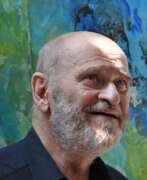

Hermann Pedit is an Austrian painter and sculptor from Lienz. For some time he attended the Innsbruck School of Painting, then studied at the Academy of Fine Arts in Vienna. He was a member of the Association of Academic Artists of East Tyrol, founded in 1956. Together with other artists, he co-founded the Vienna Synthese Gallery in 1958. Together with other artists, he founded the Municipal Gallery in Lienz in 1964. Hannes Hibler described Pedit as a classical painter, interested in eternal essence rather than fleeting moments.


Arnulf Rainer is an Austrian artist who painted in the genre of informal abstract art.
From his early works the artist was inspired by the ideas of Surrealism. He also created works of art where he applied paint over photographs and works of other artists.
In the 1950s, Rainer painted a series of blindfold paintings in the technique of Surrealist automatism. In 1978 he received the Austrian Grand National Prize. Rainer has exhibited in New York, London, Vienna, Paris, Berlin and Munich. His works are in the collections of the Albertina, the Pompidou Center, the Stedelijk Museum, the Metropolitan Museum of Art and the Museum of Modern Art.


Joseph Gallus Rittenberg is an Austrian photographer, stage designer and painter. Rittenberg grew up in Gallneukirchen and has lived in Munich since 1977. His photographs have been shown at exhibitions in Berlin, Paris, Vienna and New York, among others, and have also been published in magazines (e.g. Süddeutsche, Die Zeit and Der Spiegel) since the 1980s. His work focuses on portraits. His photographs of the writers Thomas Bernhard and Werner Schwab, Friederike Mayröcker and Ernst Jandl became well known.


Gerhard Rühm is an Austrian author, composer and visual artist.
His artistic production is inspired by August Stramm, Kurt Schwitters, Gertrude Stein, Carl Einstein und Paul Scheerbart. Rühm's works are often located at the border between music, language, gestures and the visual. His audible works are outstanding examples of innovative radio plays and acoustic art. During a sojourn in Lebanon he became interested in eastern musical styles.


Hubert Scheibl is an Austrian painter, draughtsman, and photographer, one of the most important Austrian representatives of abstract painting.
Hubert Scheibl studied with Arnulf Rainer at the Academy of Fine Arts in Vienna, lived in New York for several years, which influenced his work. In the 1980s he was a member of the Neue Wilden group.


Eva Schlegel is an Austrian artist and photographer.
She studied fine art at the University of Applied Arts in Vienna and later became professor of art and photography at the Academy of Fine Arts in Vienna.
Eva Schlegel works with photographic templates and texts, which she displays as screen prints on various materials, such as glass, and as installations.








